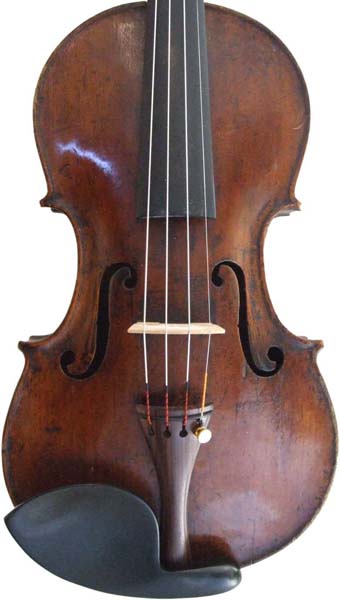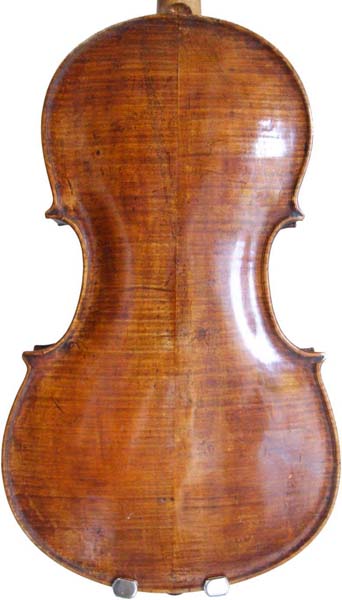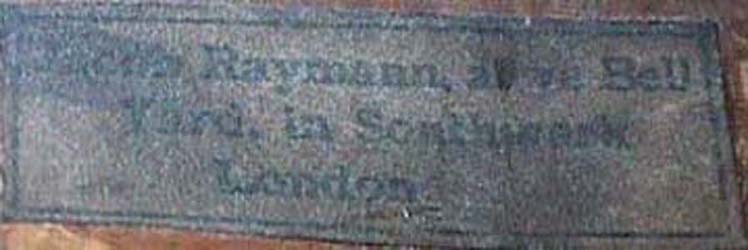

Jacob Raymann ca. 1625 |
I believe this to be one of the first issues of Jacob Raymann (1596-16??) from his first years in London. Raymann was born in Fussen, in the Tyrol, an established center of lute and viol making, where he fulfilled his apprentice-ship, but was denied entry to the 'closed' guild, ostensibly to avoid a glut of luthiers in the town. My opinion is he went over the Alps into northern Italy (Brescia? Cremona?) and learned his craft there. London immigration records suggest he spent some time in the lowlands before taking ship to England where he located himself in the cheapest quarter of London: Southwark, near the bridge, home to the newly arrived immigrants from the low countries and Germany. He seems to have held to the Brescian-Amatise pattern. He is known to have supplied the Royal Orchestra of Charles I and his tenor and alto violins were said to be unsurpassed. Historic writings tell of great admiration for the noble timbre of his instruments. Raymann, like Nicolo Amati, was known for his expertise at making contralto (viola size) and tenor (larger size) violas - then known as viols. Very few of his instruments have survived the puritanical ravages of the Cromwelian decades that preceded the Restoration. This piece was extensively and expertly repaired and refurbished by John Lauter of Arbroath, Scotland in 1882. |
 |
 |
The belly is made from finely grained spruce. The back is of two tightly grained pieces of quartersawn maple which flows in a continuous sweep across the center joint (done by turning over one of the halves of the split block before jointing) as opposed to the mirrored chevron pattern more commonly seen on two piece figured backs. Incidentally, maple of this exquisite variety was not to be had in England then or now. Even the best backs of his eminent contemporaries such as Henry Jay, Barak Norman, Duke, Banks, Wise or Hardy have never employed such finely grained and skillfully worked plates for their backs. I would guess he arrived in London with not only a chest of tools, but also at least one chest of selected tonewoods from the continent -- one of the reasons I believe this piece to be from his earliest period in London. (I have since seen a violin by Girolamo Amati, the son of Nicolo, made in 1671, which has an identical two piece back of very finely grained maple matched to form a continuous flow across the center line). This belly is mended and cleated in many spots. The sound holes are of the Brescian school and have been repaired by the skillfull addition of newer wood (mouse nibbles?). The corners emerge sharply from both the top and bottom sweeps. The arcs of both the top and bottom are pronouncedly more rounded than elliptical. The button is rudely carved, appearing to be 'dug in' deeply. Oddly, the belly has no purfling, only being scribed and inked. Oh, the time I have spent pondering his rationale for shorting the inlay! -- when, in the same piece, he has recourse to, and uses the finest of tonewoods on the planet for belly and back. |
Above is a photocopy of an inlaid back from 1645 that is unlabeled but attributed on stylistic grounds to Raymann. This extensive purfled inlaying is not a repeated feature of Raymann's work, but does belie his skill in marquetry. |
The original baroque head was saved and grafted to a new neck for the conversion, possibly by John Lauter, the restorer. The peg box is tapered and the ears are wideset with a very tiny 'eye'. |
Bushing was performed on both cheeks, and bored so precisely that they are hardly noticed. |
 |
The neck set is at the proper height for volume and playability. |
Above, the top plate is 'doubled' all around at the edges. The grain is clearly seen running in opposite directions. The outer edges of the 'f' holes show the repair pieces flitched into them. |
Ab.L., Chipping of the original varnish by fragmentation rather than abrasion. The middle shot shows the saddle, which is 'let into' the ribbing and possibly the block. |
 |
Notice that Raymann here uses the German spelling with 2 n's on this label. This was likely the first batch of labels he had printed after setting up in London, and it also follows that he would later anglicized the spelling of his surname (dropped the last n) to garner favor with the natives. Also Southwark has no 'e' at the end here -- the addition and deletion of which cycled with the current fashion. Henley's reference shows a label like this with 1650 all inked in, while one sold at Bonhams Sept. '02 lot #131 is described as "an interesting violin" labeled Jacob Raymann has the 16 printed and the 50 inked. It seems that his labels are as diverse as his creations are rare. |
The fine hand of the repairer, John Lauter of Arbroath, Scotland; penned in ink on the bottom plate in 1882. His penmanship is indicative of a man of education and breeding -- a 'gentleman's gentleman'. The works he performed on refurbishing this violin are in keeping with the finesse of his handwriting. |
MEASURES
L.O.B. 356 mm. ----- upper bout 167 mm. ----- lower bout 206 mm. waist 111 mm. ----- rib ht. 28/29mm. |
Above, a bonafide neck graft as plainly seen by the differing currents of grain. The middle shot shows the interior of the cheek to be part of the new neck |
SOUND & PLAYABILITY From the moment I first drew a note, I knew this was something very special. I have since 'sweetened it' over the years, but I have not changed the original Despiau bridge. The stop length is best at a long 12 7/8". It is the sweetest player, deep, clear, sympathetic and full of overtones. The high end is dulcet and clear. Double stops are harmonic, and easy to attain and the bridge is cut just right. |
return to the gallery page by clicking the link below http://stnichsigns.com/Makers'Orphans.html |